 W
WThe Aesthetics of Resistance is a three-volume novel by the German-born playwright, novelist, filmmaker, and painter Peter Weiss.
 W
WAll the Earth, Thrown to the Sky is a young adult fiction novel written by American author Joe R. Lansdale. It take place during the Dust Bowl depression in the mid-1930s.
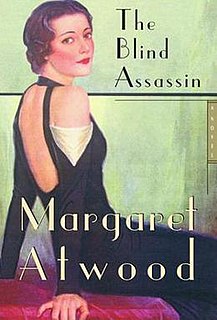 W
WThe Blind Assassin is a novel by the Canadian writer Margaret Atwood. It was first published by McClelland and Stewart in 2000. Set in Canada, it is narrated from the present day, referring to previous events that span the twentieth century.
 W
WThe Boar is a novel written by American author Joe R. Lansdale, set in East Texas in 1933 during the Great Depression.
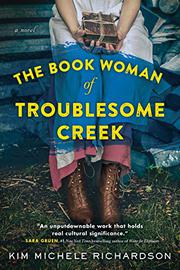 W
WThe Book Woman of Troublesome Creek is a 2019 novel by Kim Michele Richardson. The story is a fictionalized account of two real subjects in the history of eastern Kentucky: Cussy Mary is a "Book Woman" — one of the Packhorse Librarians who delivered books to remote areas of the Appalachian Mountains during the Great Depression, from 1935 to 1943, as part of President Franklin D. Roosevelt's Works Progress Administration (WPA) program. Cussy Mary is also a "Blue" — the last of a line of blue-skinned people, whose skin appears the unusual shade due to a rare genetic disorder. As a Book Woman, Cussy Mary is highly regarded, but as a Blue, she is feared and reviled, and experiences racism, discrimination and violence.
 W
WThe Bottoms is an Edgar Award-winning suspense novel by American author Joe R. Lansdale.
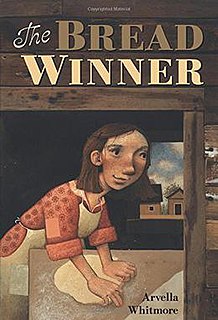 W
WThe Bread Winner is a 1990 novel by Arvella Whitmore.
 W
WBrown Girl, Brownstones is the debut novel by the internationally recognized writer Paule Marshall, first published in 1959, and dramatized by CBS Television Workshop in 1960. The story is about Barbadian immigrants in Brooklyn, New York. The book gained further recognition after it was reprinted in 1981 by the Feminist Press.
 W
WBud, Not Buddy is the second children's novel written by Christopher Paul Curtis. The first book to receive both the Newbery Medal for excellence in American children's literature, and the Coretta Scott King Award, which is given to outstanding African-American authors, Bud, Not Buddy was also recognized with the William Allen White Children's Book Award for grades 6-8.
 W
WCannery Row is a novel by American author John Steinbeck, published in 1945. It is set during the Great Depression in Monterey, California, on a street lined with sardine canneries that is known as Cannery Row. The story revolves around the people living there: Lee Chong, the local grocer; Doc, a marine biologist; and Mack, the leader of a group of derelict people.
 W
WDarkest Hour is the fifth and final novel in a series of books about the Cutler family attributed to V. C. Andrews and published in 1993. It is allegedly based on the original ideas of Andrews but was written by ghostwriter Andrew Neiderman. Andrews is the credited author.
 W
WThe Dog Star is a novel by American writer Donald Windham, first published in 1950. It tells the story of a young Southern man who is haunted by the suicide of his best friend from reform school. Set in 1930s post-Depression Atlanta, the novel's themes include dysfunctional families, traditionalism, urban anomie, homosexuality, and suicide.
 W
WA Dozen Tough Jobs is a novella by Howard Waldrop which retells the Twelve Labors of Hercules in the Depression-era American South. It was a Nebula Award finalist.
 W
WEdge of Dark Water is a murder/mystery novel written by American author Joe R. Lansdale. It was published by Mulholland Books in March 2012. A limited edition has been issued by British publisher PS Publications. It was recognized as a Booklist Editors' Choice: Adult Books for Young Adults by the American Library Association.
 W
WEsperanza Rising is a young adult historical fiction novel by Pam Muñoz Ryan.
 W
WThe Fortunate Pilgrim is a 1965 novel by American author Mario Puzo.
 W
WThe Grapes of Wrath is an American realist novel written by John Steinbeck and published in 1939. The book won the National Book Award and Pulitzer Prize for fiction, and it was cited prominently when Steinbeck was awarded the Nobel Prize in 1962.
 W
WThe Green Mile is a 1996 serial novel by American writer Stephen King. It tells the story of death row supervisor Paul Edgecombe's encounter with John Coffey, an unusual inmate who displays inexplicable healing and empathetic abilities. The serial novel was originally released in six volumes before being republished as a single-volume work. The book is an example of magical realism.
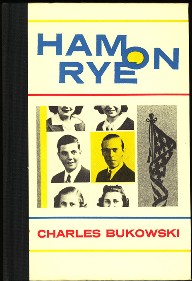 W
WHam on Rye is a 1982 semi-autobiographical novel by American author and poet Charles Bukowski. Written in the first person, the novel follows Henry Chinaski, Bukowski’s thinly veiled alter ego, during his early years. Written in Bukowski’s characteristically straightforward prose, the novel tells of his coming-of-age in Los Angeles during the Great Depression.
 W
WHarpsong is a novel by Rilla Askew published in 2007. It is volume one in Oklahoma Stories and Storytellers, from University of Oklahoma Press.
 W
WThe Hot Kid is a 2005 novel by Elmore Leonard.
 W
WIronweed is a 1983 novel by William Kennedy. It received the 1984 Pulitzer Prize for Fiction and is the third book in Kennedy's Albany Cycle. It is included in the Western Canon of the critic Harold Bloom.
 W
WThe Legend of Bagger Vance: A Novel of Golf and the Game of Life is a 1995 American novel by Steven Pressfield that was adapted into the 2000 film The Legend of Bagger Vance.
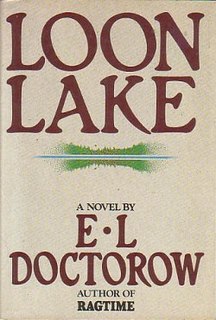 W
WLoon Lake is a novel by E. L. Doctorow published in 1980. The plot of the novel is mostly set on Loon Lake in the Adirondacks during the Depression. The novel is one of the more experimental works of Doctorow, incorporating a great variety of different techniques, many of which are used for preventing the reader from an easy understanding of the narration: traditional narratives, stream of consciousness, poetry, mixed up chronology.
 W
WMacaroni Boy is a children's historical novel by the American writer Katherine Ayres.
 W
WThe Mighty Miss Malone is a 2012 children's novel by author Christopher Paul Curtis and is a followup to his 2000 book Bud, Not Buddy. The book was released on January 10, 2012 by Wendy Lamb Books. The Mighty Miss Malone follows the character of 12-year-old African-American Deza Malone, who narrates the book.
 W
WNight and the City is the third novel by British author Gerald Kersh, published in 1938. It is a crime thriller set in 1930s London but also deals with social realism themes in the aftermath of the Great Depression.
 W
WThe Night of the Hunter is a 1953 thriller novel by American author Davis Grubb. The book was a national bestseller and a finalist for the 1955 National Book Award.
 W
WNo Promises in the Wind (1970) is a historical novel by Irene Hunt. This novel takes place in 1932 during the Great Depression. The book is about growing up during the Great Depression - that meant growing up fast as young Josh soon learned.
 W
WOf Mice and Men is a novella written by John Steinbeck. Published in 1937, it narrates the experiences of George Milton and Lennie Small, two displaced migrant ranch workers, who move from place to place in California in search of new job opportunities during the Great Depression in the United States.
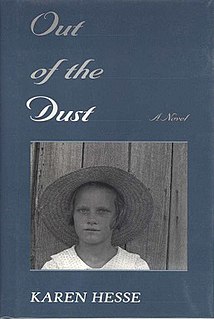 W
WOut of the Dust is a verse novel by Karen Hesse, first published in 1997.
 W
WThe Secret River is a children's fantasy book by Marjorie Kinnan Rawlings, author of The Yearling. Published in 1955, The Secret River received a Newbery Honor Award. The first edition, illustrated by Caldecott Medal winner Leonard Weisgard, was issued after Rawlings' death. The book was revised and reissued in 2009 with illustrations by Caldecott Medalists Leo and Diane Dillon. The new edition received an international children's book design award in 2012. The Secret River is the only book Rawlings wrote specifically for children. The story of young Calpurnia, who goes on a quest to find a magical river and catch fish for her starving family and friends, it has two themes common in Rawlings' writing, the magic of childhood and the struggle of people to survive in a harsh environment.
 W
WSomebody in Boots is writer Nelson Algren's first novel, based on his personal experiences of living in Texas during the Great Depression. The novel was published by Vanguard Press in 1935. The title refers to someone with material well-being and authority, as poor folk and the powerless wore shoes or went barefoot. The bosses and police feared by the poor and downtrodden wear boots, which not only symbolize their power and relative affluence, but can be used as weapons against them.
 W
WSomewhere Around the Corner is a children's novel written by Australian author Jackie French. It was her first historical novel, and chronicles the adventures of a homeless girl from 1994 who goes 'around the corner' to another time - the Great Depression.
 W
WSong of the Trees is a 1975 story by author Mildred Taylor and illustrator Jerry Pinkney. It was the first of her highly acclaimed series of books about the Logan family. The novella follows the time Mr. Anderson tried to cut down the trees on the Logan family's land. The story revolves around Cassie Logan who tries to save the trees on her Big Ma's land. Even though Cassie's family needed some money, something told Cassie the trees were just as valuable.
 W
WThimble Summer is a novel by Elizabeth Enright that won the 1939 Newbery Medal. It is set in Depression-era rural Wisconsin.
 W
WThursday's Child is young adult novel by the Australian writer Sonya Hartnett, published in 2000 by Penguin Books. Set during the 1930s Great Depression in Australia, it features a young woman Harper Flute and her family, who live in poverty. It won the annual Aurealis Award for best young-adult novel.
 W
WTobacco Road is a 1932 novel by Erskine Caldwell about Georgia sharecroppers. It was dramatized for Broadway by Jack Kirkland in 1933, and ran for eight years. A 1941 film version, deliberately played mainly for laughs, was directed by John Ford, and the storyline was considerably altered.
 W
WA Tree Full of Stars is a 1965 novel by American author Davis Grubb.
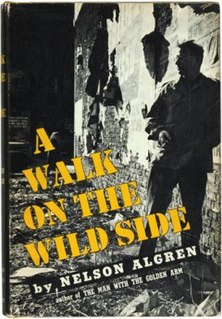 W
WA Walk on the Wild Side is a 1956 novel by Nelson Algren, also adapted into the 1962 film of the same name. Set in Depression era, it is "the tragi-comedy of Dove Linkhorn", a naive Texan drifting from his hometown to New Orleans.
 W
WWhose Names Are Unknown is an American novel by Sanora Babb, written in the 1930s but not published until 2004. It centers on members of a High Plains farm family during the Great Depression as they endure the poverty inflicted by drought and the Dust Bowl; they ultimately flee to California in hopes of building a better life but encounter a new set of hardships.
 W
WA Year Down Yonder is a novel by Richard Peck published in 2000 and won the Newbery Medal in 2001. It is a sequel to A Long Way from Chicago, which itself received a Newbery Honor.